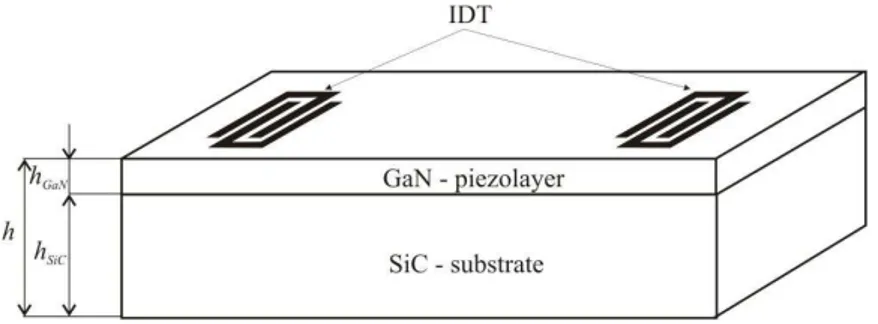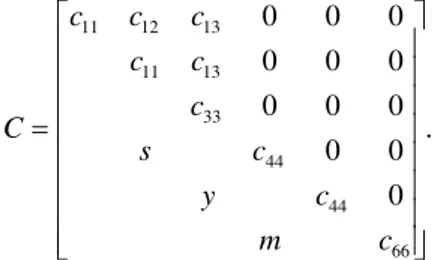Transactions of the VŠB – Technical University of Ostrava, Mechanical Series No. 1, 2013, vol. LIX
article No. 1932
Vladimír KUTIŠ*, Gabriel GÁLIK**, Ivan RÝGER***, Justín MURÍN****, Juraj HRABOVSKÝ*****, Juraj PAULECH******, Tibor LALINSKÝ*******
PIEZOELECTRIC ANALYSIS OF SAW SENSOR USING FINITE ELEMENT METHOD
PIEZOELEKTRICKÁ ANALÝZA SAW SNÍMAČA POMOCOU METÓDY KONEČNÝCH PRVKOV
Abstract
In this contribution modeling and simulation of surface acoustic waves (SAW) sensor using finite element method will be presented. SAW sensor is made from piezoelectric GaN layer and SiC substrate. Two different analysis types are investigated - modal and transient. Both analyses are only 2D. The goal of modal analysis, is to determine the eigenfrequency of SAW, which is used in following transient analysis. In transient analysis, wave propagation in SAW sensor is investigated. Both analyses were performed using FEM code ANSYS.
Abstrakt
Príspevok sa zaoberá modelovaním a simuláciou SAW snímača, ktorý využíva šírenie povrchových vĺn, pričom na simulovanie sa využíva metóda konečných prvkov. SAW snímač je zložený z piezoelektrickej GaN vrstvy a z SiC substrátu. Vyšetrované sú dva typy analýz - modálna a prechodová. Cieľom modálnej analýzy je určiť vlastnú frekvenciu SAW snímača, ktorá je následne využitá v prechodovej analýze. V prechodovej analýze sa vyšetruje šírenie sa povrchovej vlny v SAW snímači. Obe analýzy sú realizované v MKP programe ANSYS.
Keywords
SAW sensor, MEMS, piezoelectric material, FEM analysis, modal analysis, transient analysis
1 INTRODUCTION
Surface acoustic wave (SAW) device typically generate mechanical waves, which propagate on surface of piezoelectric layer. The waves are also called Rayleigh waves [1]. The velocity of
* doc., ing., PhD., Department of Applied Mechanics and Mechatronics, IPAEE, Faculty of Electrical
Engineering and Information Engineering (FEI), STU Bratislava, Ilkovicova 3, Bratislava, Slovakia, tel. (+421) 2 60291562, e-mail: vladimir.kutis@stuba.sk
**
ing., Department of Applied Mechanics and Mechatronics, IPAEE, FEI STU Bratislava, Ilkovicova 3, Bratislava, Slovakia, tel. (+421) 2 60291562, e-mail: xgalikg@is.stuba.sk
***
ing., Institute of Electrical Engineering, SAV, Dubravska cesta 9, Bratislava, Slovakia, tel. (+421) 2 5922 2919, e-mail: ivan.ryger@savba.sk
****
prof., ing., DrSc., Department of Applied Mechanics and Mechatronics, IPAEE, FEI STU Bratislava, Ilkovicova 3, Bratislava, Slovakia, tel. (+421) 2 60291611, e-mail: justin.murin@stuba.sk
*****
ing., Department of Applied Mechanics and Mechatronics, IPAEE, FEI STU Bratislava, Ilkovicova 3, Bratislava, Slovakia, tel. (+421) 2 60291559, e-mail: juraj.hrabovsky@stuba.sk
******
ing., Department of Applied Mechanics and Mechatronics, IPAEE, FEI STU Bratislava, Ilkovicova 3, Bratislava, Slovakia, tel. (+421) 2 60291452, e-mail: juraj.paulech@stuba.sk
******* ing., DrSc., Institute of Electrical Engineering, SAV, Dubravska cesta 9, Bratislava, Slovakia,
waves depends on density and elasticity material properties and are very sensitive on change of surface layer mechanical parameters (e.g. density). This sensitivity is the reason why SAW devices are so popular as sensor devices [2].
The SAW can be generated in piezoelectric material using interdigital transducer (IDT) [3]. It is basically comb-like structure with fingers connected to electric terminals (see Fig. 1). These electrodes can be fabricated by lithographic process, metal deposition and lift-off technique. The width and spacing of fingers affect the center eigenfrequency of IDT. The number of interdigital transducers affects the length of impulse characteristics and filter bandwidth [3,4]. The length of IDT fingers affects primarily the input admittance of IDT and defines the width of wave-beam, what is important when considering the diffraction effects [4]. The basic IDT concepts uses uniform transducer with equal finger lengths. By weighting the length of IDT fingers we can adjust SAW filter passband characteristics.
The paper is focused on modelling and simulation of SAW device using finite element method [5], specially by code ANSYS [6]. Two different analysis types are investigated - modal and transient. Both analyses are only 2D. The goal of modal analysis, is to determine the eigenfrequency of SAW, which is used in following transient analysis. In transient analysis, wave propagation in SAW sensor is investigated. Obtained numerical results can be used in the design of SAW sensor as well as in technology of manufacturing process of SAW sensor.
2 GEOMETRY OF SAW SENSOR
Fig. 1 shows geometry of SAW sensor made of piezoelectric GaN layer and SiC substrate. Interdigital transducers are located on both sides of sensor - one as transmitter and one as receiver. Both IDT are made from Gold.
Fig. 1 Model of SAW sensor
Position and shape of IDT are shown on Fig. 2. The distance between each pair of IDT is half of wave length , the distance between input IDT and output IDT is denoted as d and the number of IDT pairs is n.
Fig. 2 Main dimensions of SAW sensor
In our simulation, we used following wave and geometry parameters: =4m , d=3 and n=5. Height of GaN piezoelectric layer was considered in range hGaN=1.5-1.9m and the height of SiC
the left and right side of sensor and interfere with the waves. In order not to include interference of waves in simulation, the extension of SAW sensor in longitudinal direction and time of simulation has to be chosen adequately.
3 MATERIAL OF SAW SENSOR
Material properties, which have to be considered in piezoelectric analysis of SAW sensor, belong to three categories: mechanical, electrical and piezoelectrical. Mechanical properties have to be defined for all three materials, Gold (electrodes), GaN (piezolayer) and SiC (substrate), but electrical and piezoelectrical properties have to be defined only for GaN layer.
Constitutive law for mechanical behaviour can be written in matrix form as
,
C
(1)where
is stress vector,
is strain vector and
C is elasticity matrix and for transversally isotropic material can have form. 0 0 0 0 0 0 0 0 0 0 0 0 66 44 44 33 13 11 13 12 11 c m c y c s c c c c c c C (2)
Elastic properties of GaN and SiC are summarized in Tab.1, density of GaN and SiC is 6150 kg/m3 and 2329kg/m3, respectively.
Tab. 1 Elastic properties of GaN and SiC
Elastic constants
GaN [GPa] SiC [GPa]
c11 390 166
c12 145 64
c13 103 c12
c33 405 c11
c44 105 79.6
c66 123 c44
Elastic properties of Gold are defined as isotropic material properties with Young modulus 78GPa and Poisson's ratio 0.44, density is 19300 kg/m3.
Constitutive law for piezoelectric behavior can be written in matrix form as
,
,
E
e
e
D
eE
C
p E
(3)where E is vector of electric intensity, D is vector of electric displacement, ep is permitivity
matrix on condition constant strain , CE is elasticity matrix on condition constant electric intensity E
and e is matrix of piezoelectric properties.
, 0 0 0 0 0 0 11 11 11 p p p p e e e
e .
0 0 0 0 0 0 0 0 0 0 0 0 0 15 15 33 13 13 e e e e e e (4)
Electric and piezoelectric properties of GaN are summarized in Tab. 2.
Tab. 2 Electric and piezoelectric properties of GaN
electric properties - relative permitivity [-]
piezoelectric properties [pC/m2]
ep11=8.9 e13=-0.51
- e33=0.375
- e15=0.67
4 MODAL ANALYSIS OF SAW SENSOR
Modal analysis can be used to determined the eigenfrequency of SAW sensor, that can be used in transient analysis. Because the geometry of SAW sensor under IDT is periodic, we can model only small part of SAW device with length equal wave length . Only 2D model is considered. Boundary conditions have to enable periodic deformation of model. These conditions is satisfied by coupling of individual degree of freedom on left and right side of the model. Bottom of the model is fixed and the top is free - see Fig. 3 Left.
Fig. 3 Left - boundary conditions of model for modal analysis, Right - Eigenmode of SAW sensor, which causes surface waves - GaN thickness is 1.5m
Tab. 3 Obtained eigenfrequencies for different GaN thickness
GaN thickness [m]
Eigenfrequency [GHz]
1.5 1.2540
1.6 1.2723
1.7 1.2888
1.8 1.3035
1.9 1.3164
5 TRANSIENT ANALYSIS OF SAW SENSOR
Next step in simulation of SAW sensor is transient analysis that can be used to simulate real operation conditions of SAW device. To reduce computational time, we model SAW sensor as 2D system. In transient analysis only GaN thickness 1.5m was investigated. Loading of the SAW sensor is harmonic electric voltage on input IDT with amplitude 1V and with frequency equal eigenfrequency computed in modal analysis, i.e. f=1.254GHz. SAW sensor is fixed at the bottom of substrate. The total time of simulation was set to 1.2x10-8s.
The goal of the simulation is to investigate wave propagation on the surface of SAW sensor as well as induced voltage on output IDT.
Fig. 4 Deformation of SAW sensor at the end of transient analysis
Fig. 4. shows total deformation of system at the end time of simulation. As we can see from the figure, the waves propagate on the surface of the sensor, but some of them propagate also into the substrate. Damping of waves in substrate can be observed also in Fig. 5 Left, where the decrease of amplitude in transversal direction is depicted. Fig. 5 Right shows input and output voltage on IDT as a function of time. Input signal is harmonic from start of simulation, but output IDT needs some time to receive Rayleigh waves.
6 CONCLUSIONS
The paper deals with modelling and simulation of surface acoustic waves sensor using finite element method. In the modelling, FEM code ANSYS is used, where modal and transient analysis are performed. Modal analysis is used to determined eigenfrequency of the system and the frequency is used as input in transient analysis as frequency of excitation. In transient analysis with harmonic loading wave propagation is investigated. Our next research in this area will be focused on modelling of sensitive layer on the top of the SAW sensor and investigation of influence of density change on this sensitive layer caused by chemical reaction with surroundings.
ACKNOWLEDGEMENT
This work was supported in part by the following projects: Slovak Research and Development Agency under the contracts APVV-0450-10, Grant Agency KEGA - grant No. 015STU-4/2012 and VEGA No. 1/0534/12.
REFERENCES
[1] MAYERS, M. A. Dynamic behavior of materials. Chichester : John Wiley & Sons. Ltd, 1994. 688 pp. ISBN 978-0471582625.
[2] FRADEN, J. Handbook of modern sensors: Physics, Designs, and Applications. New York: Springer, 2003. 589 pp. ISBN 0387007504.
[3] DATTA, S. Surface Acoustic Wave Devices. Prentice-Hall, 1986. 208 pp. ISBN 0138779112.
[4] CAMPBELL, C. K. Surface Acoustic Wave Devices of Mobile and Wireless Communications.
Academic Presss, 1998. 631 pp. ISBN 0121573400.
[5] BURNETT, D. S. Finite Element Analysis: From Concepts to Applications. Addison Wesley Publishing Company, 1987. 844 pp. ISBN 0201108062.


![Tab. 2 Electric and piezoelectric properties of GaN electric properties - relative permitivity [-] piezoelectric properties [pC/m 2 ] e p11 =8.9 e 13 =-0.51 - e 33 =0.375 - e 15 =0.67](https://thumb-eu.123doks.com/thumbv2/123dok_br/16369351.190943/4.748.244.510.70.202/electric-piezoelectric-properties-electric-properties-permitivity-piezoelectric-properties.webp)
